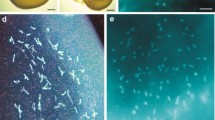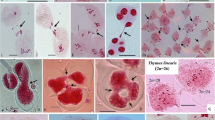Abstract
Male meiosis in autotetraploid Allium tuberosum (4×=32) is fairly regular, keeping in view its cytological status, with 81 percent of the chromosomes associated in quadrivalents and trivalents. About 5% of the cells have 32 univalents. Anaphase segregation is slightly irregular. While 48% of the pollen mitoses show 16 chromosomes, 87% of the mature pollen is viable as indicated by carmine or iodine staining. — Megaspore mother cells have 64 chromosomes associated in 32 bivalents at metaphase I. Anaphase segregation is normal. In three out of 56 cells studied multivalents, bivalents and univalents are observed as in male meiosis. — It is concluded that the species reproduces by pseudogamous parthenogenesis made possible by meiotic modification. This modification is almost perfect and almost completely specific for female meiosis. Slight effects are observed in male meiosis.
Similar content being viewed by others
Reference
Fogwill, M.: Differences in crossing over and chromosome size in the sex cells of Lilium and Fritillaria. Chromosoma (Berl.) 9, 493–504 (1958)
Gohil, R.N., Kaul, R.: Seed progeny studies in Alliums I. Numerical variants in the progeny of tetraploid Allium tuberosum. Rottl. ex Spreng. Beitr. zur Biol. Pflanzen 54, 305–309 (1979)
Gohil, R.N., Kaul, R.: Studies on male and female meiosis in Indian Allium I. Four diploid species. Chromosoma (Berl.) 77, 123–127 (1980)
Gohil, R.N., Koul, A.K.: Desynapsis in some diploid and polyploid species of Allium. Canad. J. Genet. Cytol. 13, 723–728 (1971)
Gohil, R.N., Kaul, A.K.: Some adaptive genetic-evolutionary processes accompanying polyploidy in the Indian Alliums. Bot. Not. 126, 426–432 (1973)
Håkansson, A.: Parthenogenesis in Allium. Bot. Not. (Lund), 143–179 (1951)
Håkansson, A., Levan, A.: Endo-duplicational meiosis in Allium odorum. Hereditas (Lund) 43, 179–200 (1957)
Kurita, M.: Extreme fragmentation of meiotic chromosomes in Allium tuberosum Rottl. ex. Mem. Ehime Uni., Sect. II (Sci.), Ser. B (Biol.) 4, 39–44 (1962)
Mathur, M., Tandon, S.L.: Cytology of an autotetraploid Allium tuberosum. Ind. J. Hort. 22, 382–384
Sen, S.: Floral biology, meiosis, pollen cytology and cause of seed setting in Allium tuberosum Rottl. Caryologia (Firenze) 27, 7–16 (1974)
Stearn, W.T.: Nomenclature and synonymy of Allium odorum and A. tuberosum. Herbertia 11, 226–245 (1944).
Ved Brat, S.: Genetic systems in Allium II. Sex differences in meiosis. Chromosomes today 1, 31–40 (1966)
Author information
Authors and Affiliations
Rights and permissions
About this article
Cite this article
Gohil, R.N., Kaul, R. Studies on male and female meiosis in Indian Allium . Chromosoma 82, 735–739 (1981). https://doi.org/10.1007/BF00285778
Received:
Issue Date:
DOI: https://doi.org/10.1007/BF00285778




